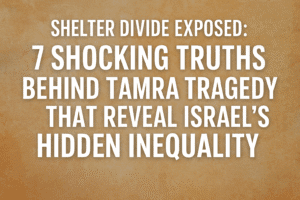Shelter Divide Exposed: 7 Shocking Truths Behind Tamra Tragedy That Reveal Israel’s Hidden Inequality
An Iranian missile strike on Tamra, Israel, killed four Palestinian citizens and exposed a stark disparity in civil defense infrastructure. The attack devastated a family home, leaving the close-knit community reeling. Crucially, Tamra’s mayor revealed only 40% of residents have access to bomb shelters, with no public bunkers available – a direct contrast to standard protections in Jewish-majority towns. This neglect, documented by Israeli rights groups for years, left residents dangerously vulnerable during the attack.
The tragedy also laid bare deep societal divisions, as verified videos showed nearby Jewish Israelis celebrating Tamra’s suffering. Knesset members condemned both the racist celebrations and the government’s long-term failure to protect Arab communities. Survivors now face ongoing trauma, with one neighbor declaring she no longer feels safe sleeping at home. The incident forces a painful examination of unequal safety standards within Israel’s borders.

A Night of Horror, A Lifetime of Neglect
Residents of Tamra, a Palestinian town near Haifa, described scenes of chaos and carnage following the Iranian strike. Emergency volunteer Mohammad Diab spoke of finding body parts littering the street, a testament to the strike’s ferocity. The Khatib family’s three-story building was pulverized, windows blown out for blocks, cars incinerated.
Neighbor Mohammad Shama offered a chilling insight: Razan Khatib, the youngest daughter, survived only because she was sleeping in the room the family used as their de facto shelter. This makeshift solution underscores the core problem articulated by Tamra’s mayor, Musa Abu Rumi: only 40% of the town’s 37,000 residents have access to a safe room or functioning shelter. Crucially, unlike virtually every Jewish town or city, Tamra has no public bomb shelters or bunkers.
“Why?” asks Mayor Abu Rumi pointedly. “The government has never financed the construction of shelters in our town because they have other priorities.”
A Glaring Gap in National Security
This isn’t merely unfortunate geography; it’s a pattern documented by Israeli rights groups and research institutes. The Israel Democracy Institute (IDI) quickly highlighted how “Arab communities remain unaddressed” nearly two years into the conflict, suffering “significant gaps in protection.” The Association for Civil Rights in Israel (ACRI) bluntly states that many Palestinian towns in the north “lack public shelters, protected areas, and shelter facilities,” a disparity most acute within Arab communities themselves.
Israeli law mandates bomb shelters in all structures built since the early 1990s – a crucial layer of defense activated by warning sirens. However, decades of underinvestment and neglect in infrastructure for Palestinian towns like Tamra have created dangerous blind spots in the nation’s civil defense network. When the sirens wailed, many in Tamra had nowhere safe to go.
The Bitter Aftermath: Division Laid Bare
The tragedy in Tamra also cast a harsh light on Israel’s deepening societal fractures. While government ministers visited the grieving town, a disturbing counter-narrative emerged from nearby Mitzpe Aviv. Social media videos, verified by CNN, showed Jewish Israelis celebrating the rockets hitting Tamra, shouting “may your village burn!”
Knesset member Dr. Ahmad Tibi called this reaction “the result of the culture of racism that has spread in Israeli society.” Fellow MK Naama Lazimi condemned the video with “shame and disgust,” linking it directly to the state’s “racist and abandoning policies.” For Tamra resident Nejmi Hijazi, the message was painfully clear: “In your own country, you are treated as a stranger, even as an enemy, even in your blood and in your death.”
Anxiety and the Absence of Safety
As the threat of further conflict looms, the people of Tamra are left with grief compounded by fear and a profound sense of vulnerability. Neighbor Manal Hijazi struggles with the haunting image of a trapped child under the rubble. Raghda, whose home next door was ravaged by the blast, described cradling her infant daughter amidst dust and debris as windows exploded around them.
“There is no way I will be sleeping at home tonight,” Raghda stated, her voice shaking. Her words encapsulate the immediate terror and the long-term insecurity facing her community.
The Uncomfortable Truth
The Iranian missile that struck Tamra didn’t just kill four civilians; it exposed a fundamental inequality. It revealed that the promise of “Never Again” and the sophisticated civil defense infrastructure Israel is known for are not equally distributed. The lack of shelters in Tamra and similar towns isn’t an oversight; it’s a symptom of systemic neglect that prioritizes some citizens’ safety over others.
The rubble in Tamra isn’t just concrete and rebar; it’s the physical manifestation of a societal divide. As Mayor Abu Rumi seeks to “bridge the gap” with visiting ministers, the question remains: Will this tragedy finally force a reckoning with the unequal distribution of the most basic human need – safety – within Israel’s own borders? The lives lost in Tamra demand nothing less.
You must be logged in to post a comment.